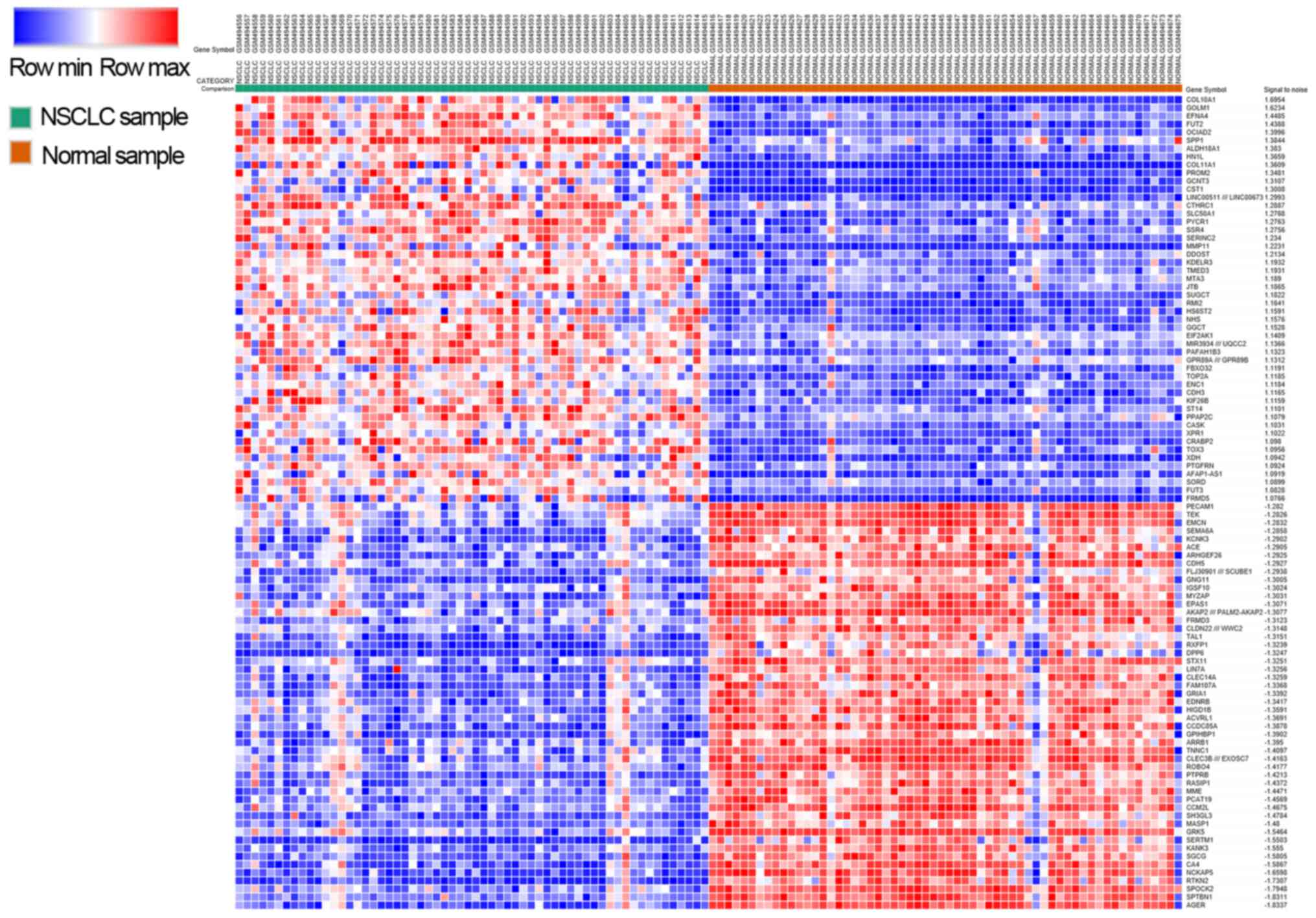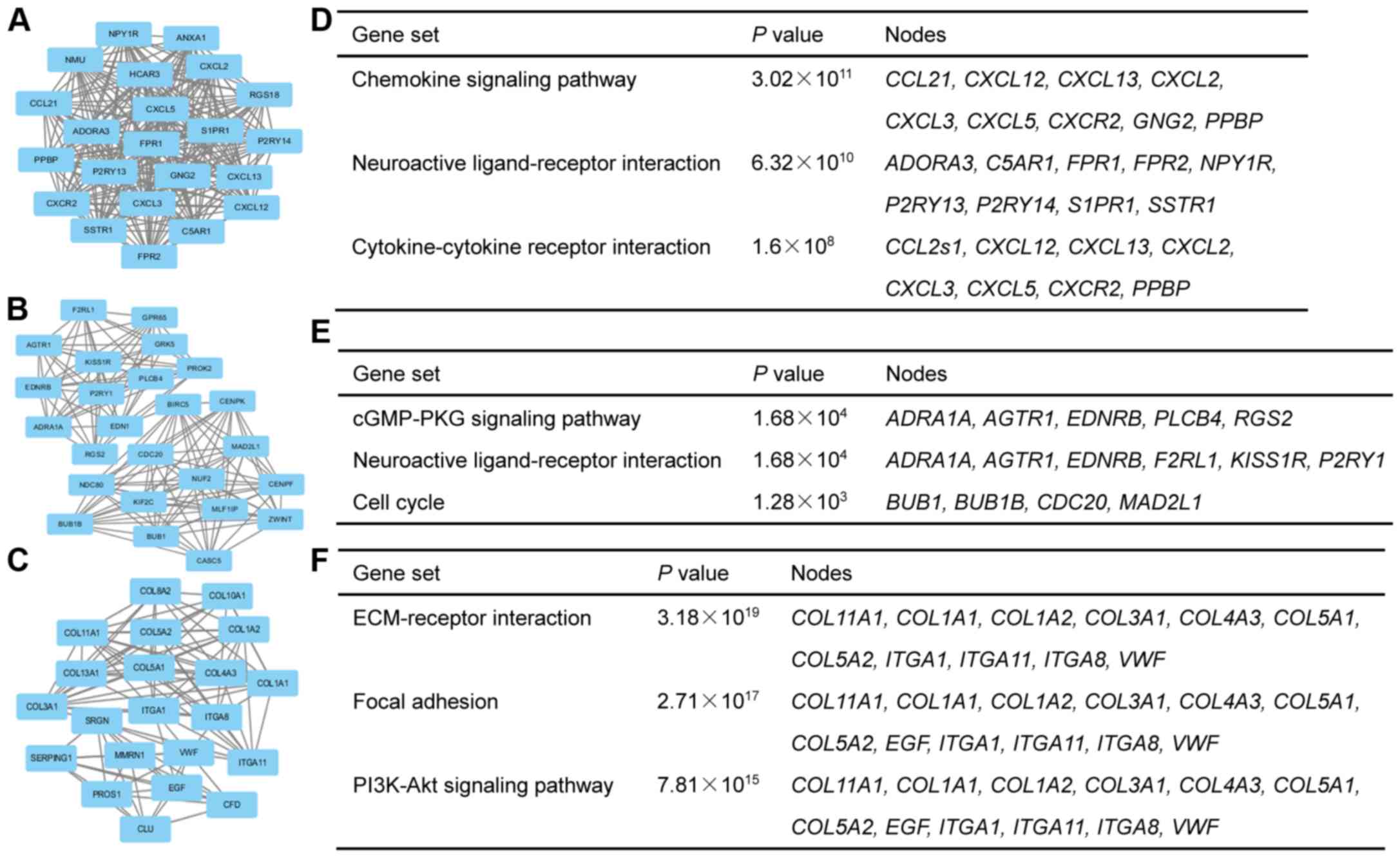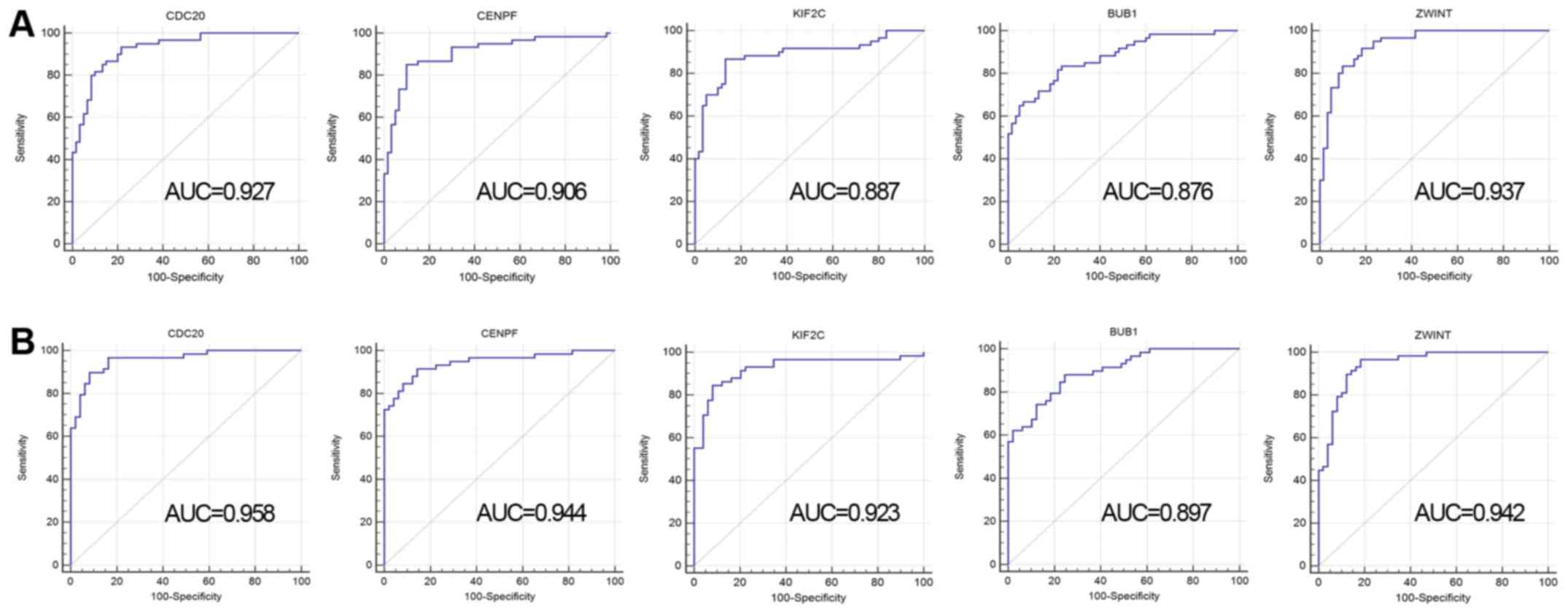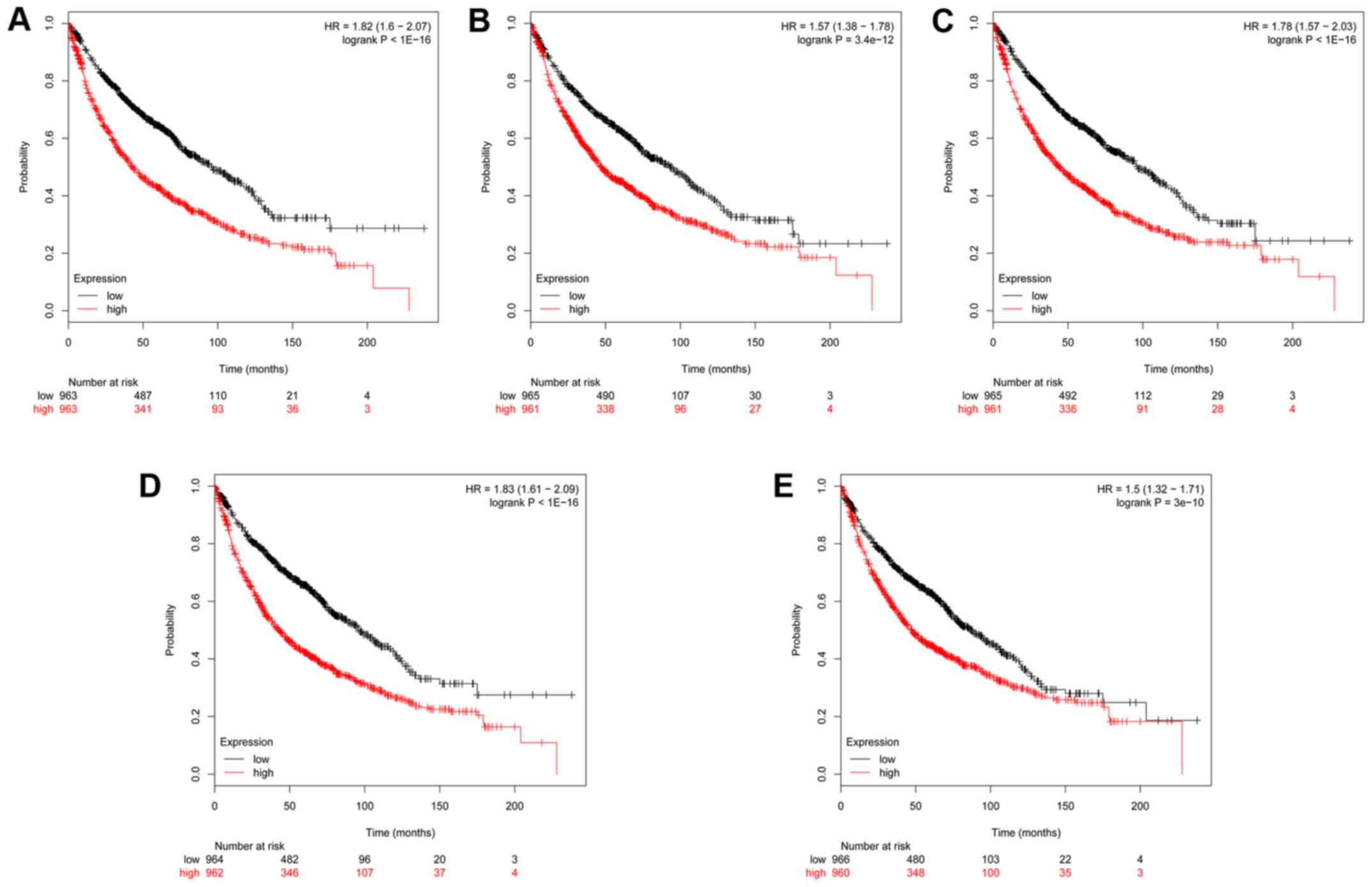Identification of potential diagnostic and prognostic biomarkers in non-small cell lung cancer based on microarray data
- Authors:
- Published online on: March 1, 2018 https://doi.org/10.3892/ol.2018.8153
- Pages: 6436-6442
-
Copyright: © Huang et al. This is an open access article distributed under the terms of Creative Commons Attribution License.
Abstract
Introduction
Lung cancer is the leading cause of cancer-associated mortalities worldwide, with ~1.6 million new cases each year (1). Non-small cell lung cancer (NSCLC) accounts for ~85% of all lung cancer cases, which consists of three major histological subtypes, including adenocarcinoma, squamous cell carcinoma and large cell carcinoma (2). Due to a lack of methods for detection of NSCLC that are suitable for the general population, NSCLC is typically diagnosed at late stages of the disease where metastasis is present (3). Therefore, it is of great importance to elucidate the molecular mechanisms underlying the pathogenesis of NSCLC and identify effective biomarkers for early diagnosis and prognosis.
Microarray technology is a high-throughput platform used to analysis gene expression and has been broadly used to obtain gene alteration during tumorigenesis and identify prognostic biomarkers in patients with cancer (4–6). However, genes identified by one cohort may be difficult to be confirmed in other cohorts (7). Therefore, in order to address this problem, it is necessary to validate genes in several individual studies.
In the present study, the aim was to identify the potential genes that serve as diagnostic and prognostic biomarkers for patients with NSCLC through retrieving the microarray data from public databases and comprehensive bioinformatics analysis. Gene expression profiles between tumor and adjacent normal tissues were illustrated, and differentially expressed genes (DEGs) based on the GSE19804 dataset were identified. By combining functional pathway and protein-protein interaction (PPI) analyses, five hub genes were selected, including cell division cycle 20 (CDC20), centromere protein F (CENPF), kinesin family member 2C (KIF2C), BUB1 mitotic checkpoint serine/threonine kinase (BUB1) and ZW10 interacting kinetochore protein (ZWINT). Furthermore, the levels of mRNA expression of these genes were validated using an additional dataset (GSE10072) and NSCLC cell lines. Receiver operating characteristic (ROC) curves and survival analyses were employed to evaluate the diagnostic and prognostic potentials of five hub genes.
Materials and methods
Microarray data
The gene expression profiles of GSE19804 and GSE10072 were obtained from the Gene Expression Omnibus (GEO, http://www.ncbi.nlm.nih.gov/geo). These two gene expression datasets were analyzed using the Affymetrix platform (Affymetrix Human Genome U133 Plus 2.0 Array; Thermo Fisher Scientific, Inc., Waltham, MA, USA). The GSE19804 gene expression profile submitted by Lu et al (8) included 60 pairs of clinical NSCLC samples, which consisted of 56 adenocarcinoma, 3 bronchioloalveolar carcinoma, and 1 squamous carcinoma, and corresponding adjacent normal tissue samples. The GSE10072 gene expression profile consisted of 58 adenocarcinoma samples (16 non-smokers, 18 former smokers and 24 current smokers) and 49 non-tumor samples (15 non-smokers, 18 former smokers and 16 current smokers) (9).
Processing of data
Raw microarray data files of the two datasets were downloaded from the GEO database. GEO2R (http://www.ncbi.nlm.nih.gov/geo/geo2r/), an online tool that compares two or more groups of samples in the same experimental setting, was used to analyze the raw data (10). False Discovery Rate (FDR) adjusted P-value of 0.05 and |logFC|>1 were set as the cut-off criteria.
Functional and pathway enrichment analyses of DEGs
Gene ontology (GO) analysis was processed by the Database for Annotation, Visualization and Integrated Discovery (DAVID) (http://david.abcc.ncifcrf.gov/) to elucidate the biological function of genes in NSCLC. Kyoto Encyclopedia of Genes and Genomes (KEGG) pathway enrichment analysis was performed to identify DEGs using the DAVID database. P<0.05 was set as the threshold.
Construction of PPI network and module analysis
The functional interaction of proteins can shed light on the molecular mechanism underlying NSCLC. The online database STRING (version 10.0, http://string.embl.de/) can be used in the evaluation of PPIs (11). The STRING database includes 9,643,763 proteins from 2,031 organisms. In order to evaluate the PPIs among the DEGs, DEGs were mapped to the STRING database. A confidence score >0.7 was selected as significant. In addition, the degree of the nodes in PPI network was calculated, and the nodes with a higher degree were selected as hub proteins. Furthermore, Cytoscape software (version 3.4.0, http://cytoscape.org/) was employed to construct PPI networks. The plug-in Molecular Complex Detection (MCODE) was performed to screen modules of the PPI network with the threshold set as follows: MCODE scores >10. The GO and KEGG analysis of genes in the module was performed using the DAVID online tool as aforementioned.
Cell culture
The cell lines, human bronchial epithelial (HBE1), A549 and H322, were gifted from Professor Zeyao Tang (Dalian Medical University, Dalian, China) (12). The cells were maintained in high-glucose Dulbecco's modified Eagles medium (Gibco; Thermo Fisher Scientific, Inc.) supplemented with 10% fetal bovine serum (GE Healthcare Life Sciences, Logan, UT, USA), 100 U/ml penicillin and 100 µg/ml streptomycin (Gibco; Thermo Fisher Scientific, Inc.). The cells were incubated at 37°C in a humidified chamber with 5% CO2.
Reverse transcription-quantitative polymerase chain reaction (RT-qPCR)
Total RNA from cells lines, including HBE1, A549, and H322, were extracted by using the TRIzol® regent (Invitrogen; Thermo Fisher Scientific, Inc.). The cDNA of mRNA was synthesized using the PrimeScript™ RT reagent kit (Takara Bio Inc., Otsu, Japan). RT-qPCR was carried out using the 7500 Real-time PCR system (Thermo Fisher Scientific, Inc.) at 95°C for initial denaturation for 10 min, followed by 40 cycles at 95°C for 15 sec, and 60°C for 1 min with the SYBR® Green mix (Takara Bio Inc., Japan). Data were analyzed by using the comparative Cq (ΔΔCq) to determine the relative gene expression, and GAPDH was used as an endogenous control (13). The primers were synthesized by Shanghai GenePharma Co., Ltd., (Shanghai, China). The following primer pairs was used to measure the amount of GAPDH: Forward, 5′-GGAGCGAGATCCCTCCAAAAT-3′ and reverse, 5′-GGCTGTTGTCATACTTCTCATGG-3′.
ROC analysis
ROC curve analysis was performed using the MedCalc software packages (version 16.8.4; MedCalc Software bvba, Ostend, Belgium). The area under the curve (AUC) values with 95% confidence interval (CI) were calculated to evaluate the overall performance of the diagnostic tests.
Survival analysis of hub genes
Kaplan-Meier plotter (www.kmplot.com), an online survival analysis tool, was used to evaluate the prognostic value of biomarkers of breast, ovarian, lung and gastric cancer (14). Patients with NSCLC were divided into high and low expression groups using the median level, which was included in the low expression group, as the cutoff value. To analyze the association between gene expression and clinical outcomes, Kaplan-Meier plots was employed to compare the overall survival ratio between the two groups, and the log rank P-value and hazard ratio (HR) with 95% confidence intervals (CI) were calculated and displayed.
Statistical analysis
The data are expressed as the mean ± standard deviation of three replicates. Statistical differences were assessed using one-way analysis of variance test and Tukey's multiple comparisons test. SPSS software (version 17.0; SPSS, Inc., Chicago, IL, USA) was used to analyze the data. P<0.05 was considered to indicate a statistically significant difference.
Results
Identification of DEGs
By using the threshold (adjusted P-vale of 0.05 and fold change >2), a total of 1,412 DEGs were identified in the GSE19804 dataset. Among these genes, 453 genes were upregulated, and 959 genes were downregulated. A heat-map illustrating the expression of the top 50 up and downregulated DEGs is shown in Fig. 1.
Analysis of GO terms and KEGG pathway enrichment
To further elucidate the functions of the identified DEGs in NSCLC, GO and KEGG pathway enrichment analyses were employed. As shown in Table I, GO analysis of upregulated DEGs in NSCLC indicated that these genes were associated with ‘mitotic cell cycle’, ‘mitotic nuclear division’ and the ‘cell cycle process’. KEGG pathway enrichment analysis of DEGs revealed that upregulated DEGs were largely enriched in cell cycle and extracellular matrix (ECM)-receptor interaction pathways, while downregulated DEGs were enriched in ‘malaria’ and ‘tumor necrosis factor (TNF) signaling pathways’ (Table I). These results suggest that upregulated DEGs in NSCLC may be largely involved in the progression of the cell cycle.
Table I.Functional and pathway enrichment analysis of upregulated and downregulated genes in non-small cell lung cancer. |
Construction of PPI network and selection of modules
Based on the analysis of DEGs in the STRING database, a PPI network of DEGs containing 1,291 nodes and 2,854 edges was constructed. By using the plug-in MCODE in Cytoscape, the top 3 modules in the PPI network was obtained (Fig. 2A-C), and KEGG analysis of genes in the corresponding modules was also performed (Fig. 2D-F). Consistent with the KEGG analysis of DEGs, function enrichment analysis of genes in the top 3 modules indicated that these hub genes were also enriched in ‘cell cycle progression’ (Fig. 2E). Therefore, the present study focused on the 5 hub genes associated with cell cycle progression including CDC20, CENPF, KIF2C, BUB1 and ZWINT.
Validation of 5 selected hub genes
Although 5 hub genes were selected by KEGG analysis the genes in these 3 modules, these 5 selected genes may be limited to the diagnosis or prognosis for non-smoking female patients with NSCLC. In order to elucidate whether these genes can be non-selectively applied to patients with NSCLC, as previously reported (4,15), an additional dataset and RT-qPCR were employed to validate the mRNA level of these genes in NSCLC samples and cell lines. Since the GSE19804 dataset included 56 non-smoking female adenocarcinoma samples (8), the present study searched for a dataset that included adenocarcinoma and simultaneously excluded the effects of sex and smoking. Based on the aforementioned criterion, the GSE10072 database was identified as suitable. Using the GSE10072 dataset, it was detected that the mRNA level of these 5 genes were also overexpressed in NSCLC samples (Fig. 3A-E). In addition, the RT-qPCR results also validated that the mRNA level of these genes were overexpressed in NSCLC cell lines including A549 and H322 (16), when compared with the control cell line HBE1 (Fig. 3F). H322 may be identical to another uncommonly used NSCLC cell line H322M (https://web.expasy.org/cellosaurus/CVCL_1556). Taken together, these results suggest that these 5 hub genes may be novel gene signatures for patients with NSCLC.
ROC analysis of selected hub genes
To evaluate the diagnostic value of these 5 hub genes, ROC analysis was conducted based on these 2 datasets. The present study demonstrated that the sensitivity and specificity of these 5 genes was relatively high. As shown in Fig. 4A, the AUC values for CDC20, CENPF, KIF2C, BUB1 and ZWINT were 0.927, 0.906, 0.887, 0.876, and 0.937, respectively in the GSE19804 dataset, while the values were 0.958, 0.944, 0.923, 0.897, and 0.942, respectively in the GSE10072 dataset (Fig. 4B). These results indicate that these 5 hub genes may be sensitive and specific in distinguishing NSCLC tissues from normal tissues.
Kaplan-Meier plotter analysis of selected hub genes
The prognostic value of these 5 genes in PPI network was evaluated using the Kaplan-Meier plotter as previous described (14). Based on the low and high expression of each hub gene, the overall survival of patients with NSCLC was obtained for each gene. As shown in Fig. 5, the high mRNA expression of CDC20 (HR, 1.82; CI, 1.6–2.07) was associated with a poorer overall survival for patients with NSCLC. Similar associations were detected for: CENPF (HR, 1.57, CI, 1.38–1.78), KIF2C (HR, 1.78; CI, 1.57–2.03), BUB1 (HR, 1.83; CI, 1.61–2.09) and ZWINT (HR, 1.5; CI, 1.32–1.71). These results indicate that these 5 hub genes may serve as potential prognostic biomarkers for patients with NSCLC.
Discussion
In the present study, the mRNA level of five genes identified from the GSE19804 dataset, CDC20, CENPF, KIF2C, BUB1 and ZWINT, were demonstrated to be upregulated in NSCLC samples. This was validated using the GSE10072 dataset and RT-qPCR. By employing ROC curve and Kaplan-Meier plotter analyses, it was further demonstrated that these five candidates were sensitive and specific in distinguishing NSCLC tissues from normal tissues, and these candidate genes were associated with a poor overall survival in patients with NSCLC.
Although advances in surgery and chemotherapy have improved the prognosis of patients with NSCLC, NSCLC remains the leading cause of cancer-associated mortalities worldwide (1). However, due to a lack of specific biomarkers and typical symptoms, patients with NSCLC are commonly diagnosed at late stages of the disease (3). Therefore, it is important to elucidate the molecular mechanisms of NSCLC and identify more specific biomarkers for patients with NSCLC.
A combination of high-throughput sequencing and bioinformatics analysis has been previously employed to search for sensitive biomarkers for patients with NSCLC (4,8). In the present study, in order to identify potential biomarkers of NSCLC, the gene expression profiles in the dataset GSE19804 were obtained and DEGs in NSCLC tissues were subsequently identified (Fig. 1). Using a combination of PPI analysis and subsequent selection of modules, five hub genes (CDC20, CENPF, KIF2C, BUB1 and ZWINT) that were overexpressed in NSCLC tissues were selected as potential candidates (Fig. 2). However, the repeatability of a study with a single dataset is usually insufficient. Therefore, an additional two methods were used to validate the overexpression of selected genes in NSCLC tissues and cell lines. The upregulation of the candidate genes were validated by using the GSE10072 dataset and by RT-qPCR (Fig. 3). The 5 candidates were further evaluated using the ROC and Kaplan-Meier plotter analyses to assess their diagnostic and prognostic values. Notably, the results obtained were consistent with those of previous studies (4,6). These identified candidates were also verified to be potential diagnostic and prognostic biomarkers for patients with NSCLC.
The cell cycle is an evolutionarily conserved process that is regulated by several molecules, including cyclins and cyclin-dependent kinases. Cell cycle is critical for the growth and development of mammalian cells (17). Mutations in these proteins and subsequent cell cycle aberrations are common hallmarks of human cancer (18). Although these aberrant cell cycle-associated molecules are not specific to a particular cancer type, they can still serve as potential candidates for the diagnosis or prognosis of patients with cancer (4,15). For instance, the level of cyclinB2, a member of the cyclin family, has been regarded as an unfavorable predictor for the clinical progression and prognosis for patients with NSCLC (19). The present study also identified 5 cell cycle-associated candidates (20–24), which are sensitive and specific in distinguishing NSCLC from normal tissues, and these candidate genes were associated with poor prognosis of NSCLC. Among these candidates, the overexpression of CDC20 has been used to predict the poor prognosis of patients with NSCLC (25). Furthermore, a number of chemotherapeutics have been designed to target these cell cycle-associated molecules and therefore eradicate cancer cells (26). The present study postulates that these 5 identified candidates may possess the potential to serve as novel therapeutic targets for patients with NSCLC.
In summary, the present study has demonstrated that the candidates CDC20, CENPF, KIF2C, BUB1, and ZWINT are overexpressed in NSCLC tissues, which may be unfavorable prognostic biomarkers for patients with NSCLC. By classifying patients into high- and low-risk groups, patients may benefit from more accurate decision-making in treatment selection and ultimately have an improved clinical outcome. However, due to the different histopathological typing and grouping methods used in the two datasets, further validation of these five candidates for their diagnostic and prognostic values in the clinical samples are required.
Acknowledgments
Not applicable.
Funding
No funding was received.
Availability of data and materials
The datasets used and/or analyzed during the current study are available from the corresponding author on reasonable request.
Author's contributions
LG initiated the project and designed the research plan. RH performed the experiments and analyzed the data. RH and LG wrote and approved the manuscript.
Ethics approval and consent to participate
Not applicable.
Consent for publication
Not applicable.
Competing interests
The authors declare that they have no competing interests.
References
|
Smith RA, Manassaram-Baptiste D, Brooks D, Doroshenk M, Fedewa S, Saslow D, Brawley OW and Wender R: Cancer screening in the United States, 2015: A review of current American cancer society guidelines and current issues in cancer screening. CA Cancer J Clin. 65:30–54. 2015. View Article : Google Scholar : PubMed/NCBI | |
|
Thomas A, Liu SV, Subramaniam DS and Giaccone G: Refining the treatment of NSCLC according to histological and molecular subtypes. Nat Rev Clin Oncol. 12:511–526. 2015. View Article : Google Scholar : PubMed/NCBI | |
|
van Meerbeeck JP, Fennell DA and De Ruysscher DK: Small-cell lung cancer. Lancet. 378:1741–1755. 2011. View Article : Google Scholar : PubMed/NCBI | |
|
Lu Y, Lemon W, Liu PY, Yi Y, Morrison C, Yang P, Sun Z, Szoke J, Gerald WL, Watson M, et al: A gene expression signature predicts survival of patients with stage I non-small cell lung cancer. PLoS Med. 3:e4672006. View Article : Google Scholar : PubMed/NCBI | |
|
Chen F, Xiang CX, Zhou Y, Ao XS, Zhou DQ, Peng P, Zhang HQ, Liu HD and Huang X: Gene expression profile for predicting survival of patients with meningioma. Int J Oncol. 46:791–797. 2015. View Article : Google Scholar : PubMed/NCBI | |
|
Xu Z, Zhou Y, Cao Y, Dinh TL, Wan J and Zhao M: Identification of candidate biomarkers and analysis of prognostic values in ovarian cancer by integrated bioinformatics analysis. Med Oncol. 33:1302016. View Article : Google Scholar : PubMed/NCBI | |
|
Ioannidis JP, Allison DB, Ball CA, Coulibaly I, Cui X, Culhane AC, Falchi M, Furlanello C, Game L, Jurman G, et al: Repeatability of published microarray gene expression analyses. Nat Genet. 41:149–155. 2009. View Article : Google Scholar : PubMed/NCBI | |
|
Lu TP, Tsai MH, Lee JM, Hsu CP, Chen PC, Lin CW, Shih JY, Yang PC, Hsiao CK, Lai LC and Chuang EY: Identification of a novel biomarker, SEMA5A, for non-small cell lung carcinoma in nonsmoking women. Cancer Epidemiol Biomarkers Prev. 19:2590–2597. 2010. View Article : Google Scholar : PubMed/NCBI | |
|
Landi MT, Dracheva T, Rotunno M, Figueroa JD, Liu H, Dasgupta A, Mann FE, Fukuoka J, Hames M, Bergen AW, et al: Gene expression signature of cigarette smoking and its role in lung adenocarcinoma development and survival. PLoS One. 3:e16512008. View Article : Google Scholar : PubMed/NCBI | |
|
Barrett T, Wilhite SE, Ledoux P, Evangelista C, Kim IF, Tomashevsky M, Marshall KA, Phillippy KH, Sherman PM, Holko M, et al: NCBI GEO: Archive for functional genomics data sets-update. Nucleic Acids Res. 41:(Database Issue). D991–D995. 2013. View Article : Google Scholar : PubMed/NCBI | |
|
Szklarczyk D, Franceschini A, Wyder S, Forslund K, Heller D, Huerta-Cepas J, Simonovic M, Roth A, Santos A, Tsafou KP, et al: STRING v10: Protein-protein interaction networks, integrated over the tree of life. Nucl Acids Res. 43:(Database Issue). D447–D452. 2015. View Article : Google Scholar : PubMed/NCBI | |
|
Sun B, Gao L, Ahsan A, Chu P, Song Y, Li H, Zhang Z, Lin Y, Peng J, Song Z, et al: Anticancer effect of SZC015 on lung cancer cells through ROS-dependent apoptosis and autophagy induction mechanisms in vitro. Int Immunopharmacol. 40:400–409. 2016. View Article : Google Scholar : PubMed/NCBI | |
|
Livak KJ and Schmittgen TD: Analysis of relative gene expression data using real-time quantitative PCR and the 2(-Delta Delta C(T)) method. Methods. 25:402–408. 2001. View Article : Google Scholar : PubMed/NCBI | |
|
Győrffy B, Surowiak P, Budczies J and Lanczky A: Online survival analysis software to assess the prognostic value of biomarkers using transcriptomic data in non-small-cell lung cancer. PLoS One. 8:e822412013. View Article : Google Scholar : PubMed/NCBI | |
|
Shi YX, Zhu T, Zou T, Zhuo W, Chen YX, Huang MS, Zheng W, Wang CJ, Li X, Mao XY, et al: Prognostic and predictive values of CDK1 and MAD2L1 in lung adenocarcinoma. Oncotarget. 7:85235–85243. 2016. View Article : Google Scholar : PubMed/NCBI | |
|
Gong Y, Yao E, Shen R, Goel A, Arcila M, Teruya-Feldstein J, Zakowski MF, Frankel S, Peifer M, Thomas RK, et al: High expression levels of total IGF-1R and sensitivity of NSCLC cells in vitro to an anti-IGF-1R antibody (R1507). PLoS One. 4:e72732009. View Article : Google Scholar : PubMed/NCBI | |
|
Dominguez-Brauer C, Thu KL, Mason JM, Blaser H, Bray MR and Mak TW: Targeting mitosis in cancer: Emerging strategies. Mol Cell. 60:524–536. 2015. View Article : Google Scholar : PubMed/NCBI | |
|
Hydbring P, Malumbres M and Sicinski P: Non-canonical functions of cell cycle cyclins and cyclin-dependent kinases. Nat Rev Mol Cell Biol. 17:280–292. 2016. View Article : Google Scholar : PubMed/NCBI | |
|
Qian X, Song X, He Y, Yang Z, Sun T, Wang J, Zhu G, Xing W and You C: CCNB2 overexpression is a poor prognostic biomarker in Chinese NSCLC patients. Biomed Pharmacother. 74:222–227. 2015. View Article : Google Scholar : PubMed/NCBI | |
|
Frescas D and Pagano M: Deregulated proteolysis by the F-box proteins SKP2 and beta-TrCP: Tipping the scales of cancer. Nat Rev Cancer. 8:438–449. 2008. View Article : Google Scholar : PubMed/NCBI | |
|
Varis A, Salmela AL and Kallio MJ: Cenp-F (mitosin) is more than a mitotic marker. Chromosoma. 115:288–295. 2006. View Article : Google Scholar : PubMed/NCBI | |
|
Wordeman L: Microtubule-depolymerizing kinesins. Curr Opin Cell Biol. 17:82–88. 2005. View Article : Google Scholar : PubMed/NCBI | |
|
Taylor SS and McKeon F: Kinetochore localization of murine Bub1 is required for normal mitotic timing and checkpoint response to spindle damage. Cell. 89:727–735. 1997. View Article : Google Scholar : PubMed/NCBI | |
|
Seo Woo D, You Yeop S, Chung WJ, Cho DH, Kim JS and Oh Su J: Zwint-1 is required for spindle assembly checkpoint function and kinetochore-microtubule attachment during oocyte meiosis. Sci Rep. 5:154312015. View Article : Google Scholar : PubMed/NCBI | |
|
Kato T, Daigo Y, Aragaki M, Ishikawa K, Sato M and Kaji M: Overexpression of CDC20 predicts poor prognosis in primary non-small cell lung cancer patients. J Surg Oncol. 106:423–430. 2012. View Article : Google Scholar : PubMed/NCBI | |
|
Malumbres M: Therapeutic opportunities to control tumor cell cycles Clin Transl Oncol. 8:399–408. 2006.PubMed/NCBI |














